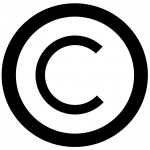AI Literacy for College Students Video Series Dr. Nic Subtirelu of the English Department at…
 What is Copyright?
What is Copyright?
Copyright is a type of intellectual property that protects original works of authorship as soon as an author fixes the work in a tangible form of expression. Visit https://www.copyright.gov/ to learn more about the basics of copyright.
Additional resources:
- POLICY Board of Trustees: Use of Copyrighted Materials
- Policy Notice on Copyright Violations
- Student Release of Course Materials for Public Availability
- Creative Commons: A standard way to legally share your work
What is the TEACH Act?
Copyright law provides educators with a separate set of rights in addition to fair use, to display (show) and perform (show or play) others’ works in the classroom. These rights are in Section 110(1) of the Copyright Act and apply to any work, regardless of the medium.
Until recently, however, when the classroom was remote, the law’s generous terms for face-to-face teaching in Section 110(1) shrank dramatically in Section 110(2) — some would say to the vanishing point!
These severe limitations on what could be performed in distance education received lots of attention. In 1998, Congress directed the Copyright Office to prepare a report recommending what should be done to facilitate the use of digital technologies in distance education.
The Copyright Office prepared its report and recommended significant changes. In March 2001, a bill was introduced closely tracking the Copyright Office’s recommendations. It took almost 2 years, but the TEACH Act finally became law in late 2002.
The TEACH Act expands the scope of educators’ rights to perform and display works and to make the copies integral to such performances and displays for digital distance education, making the rights closer to those we have in face-to-face teaching. But there is still a considerable gap between what the statute authorizes for face-to-face teaching and for distance education. For example, as indicated above, an educator may show or perform any work related to the curriculum, regardless of the medium, face-to-face in the classroom – still images, music of every kind, even movies. There are no limits and no permission required. Under 110(2), however, even as revised and expanded, the same educator would have to pare down some of those materials to show them to distant students. The audiovisual works and dramatic musical works may only be shown as clips — “reasonable and limited portions,” the Act says.
Additional Resources
What is the TEACH Act and how can you protect yourself from copyright infringement?
The Technology, Education, and Copyright Harmonization Act, an amendment to copyright law, was signed into law by President Bush on November 2, 2002.
For more information on how to make web-based learning technologies accessible, visit the Making Web-Based Learning Technologies Accessible website.

This Post Has 0 Comments